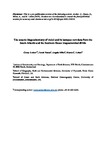The oceanic biogeochemistry of nickel and its isotopes: New data from the South Atlantic and the Southern Ocean biogeochemical divide
| dc.contributor.author | Archer, C | |
| dc.contributor.author | Vance, D | |
| dc.contributor.author | Milne, Angela | |
| dc.contributor.author | Lohan, MC | |
| dc.date.accessioned | 2020-03-08T16:48:32Z | |
| dc.date.issued | 2020-04-01 | |
| dc.identifier.issn | 0012-821X | |
| dc.identifier.issn | 1385-013X | |
| dc.identifier.other | 116118 | |
| dc.identifier.uri | http://hdl.handle.net/10026.1/15435 | |
| dc.description | 12 months embargo | |
| dc.description.abstract |
Nickel (Ni) is important for a number of enzymes in oceanic phytoplankton. It has received less attention than some other bioactive metals because it is not reduced to extremely low dissolved concentrations in the photic zone. However, there are strong indications in previous studies that this residual pool is not bio-available. Oceanic Ni isotope data are still scarce, but have great potential for understanding this issue, as well as for understanding the Ni mass balance of the oceans now and in the past. Here, we present new concentration and isotope data for the UK GEOTRACES section at 40°S in the Atlantic (GA10). Nickel concentration data show typical nutrient-like profiles, slightly modified by variable pre-formed concentrations in sub-surface water masses, e.g. North Atlantic Deep Water. Nickel isotopes, in common with findings in previous studies, are homogeneous beneath 500 m, at about +1.3‰ in δ60Ni, in samples with Ni concentrations above 3-3.5 nM. The surface South Atlantic, however, has concentrations below 3 nM, and shows significantly higher δ60Ni, up to +1.74‰, that are closely anti-correlated with Ni concentrations. The data for the deep South Atlantic dissolved pool, with a δ60Ni = 1.31 ± 0.12‰ (average and 2SD) confirm the homogeneity of the global deep ocean, which previous data demonstrate extends all the way to the surface in the upwelling zone of the Southern Ocean south of the Polar Front. This Ni isotope composition is significantly heavier than known inputs to the oceanic dissolved pool. This mass balance requires an isotopically light sink that may be represented by sedimentary Mn-oxide associated Ni. The magnitude of the isotope fractionation implied by the upper ocean data is not consistent with plausible potential abiotic removal processes. Rather, these data are best explained by biological uptake. However, consideration of the detailed relationships between Ni concentrations and isotope compositions requires that a substantial portion of the oceanic dissolved Ni pool is not bio-available. The data are consistent either with a small preference for the light isotope during uptake (about 0.1‰) or two distinct pools of dissolved Ni, one bio-available and one strongly bound in organic complexes, with limited isotopic exchange between them. Patterns of co-variation in Ni concentrations and isotopes with the major nutrients point to strong contrasts across the Polar Front of the Southern Ocean, contrasts that exhibit both similarities and differences with those for the major nutrients and other trace metal micronutrients. South of the Polar Front, Ni is taken up in modest amounts by diatoms, without isotope fractionation. North of the Polar Front the data are most consistent with cyanobacteria as the dominant control on Ni uptake, leading to significant coupled abundance and isotope variation. | |
| dc.format.extent | 116118-116118 | |
| dc.language | en | |
| dc.language.iso | en | |
| dc.publisher | Elsevier BV | |
| dc.subject | GEOTRACES | |
| dc.subject | nickel isotopes | |
| dc.subject | Southern Ocean biogeochemistry | |
| dc.subject | Antarctic Polar Front | |
| dc.title | The oceanic biogeochemistry of nickel and its isotopes: New data from the South Atlantic and the Southern Ocean biogeochemical divide | |
| dc.type | journal-article | |
| dc.type | Journal Article | |
| plymouth.author-url | https://www.webofscience.com/api/gateway?GWVersion=2&SrcApp=PARTNER_APP&SrcAuth=LinksAMR&KeyUT=WOS:000525394500017&DestLinkType=FullRecord&DestApp=ALL_WOS&UsrCustomerID=11bb513d99f797142bcfeffcc58ea008 | |
| plymouth.volume | 535 | |
| plymouth.publication-status | Published | |
| plymouth.journal | Earth and Planetary Science Letters | |
| dc.identifier.doi | 10.1016/j.epsl.2020.116118 | |
| plymouth.organisational-group | /Plymouth | |
| plymouth.organisational-group | /Plymouth/Faculty of Science and Engineering | |
| plymouth.organisational-group | /Plymouth/Faculty of Science and Engineering/School of Geography, Earth and Environmental Sciences | |
| plymouth.organisational-group | /Plymouth/REF 2021 Researchers by UoA | |
| plymouth.organisational-group | /Plymouth/REF 2021 Researchers by UoA/UoA07 Earth Systems and Environmental Sciences | |
| plymouth.organisational-group | /Plymouth/Research Groups | |
| plymouth.organisational-group | /Plymouth/Research Groups/BEACh | |
| plymouth.organisational-group | /Plymouth/Users by role | |
| plymouth.organisational-group | /Plymouth/Users by role/Academics | |
| dcterms.dateAccepted | 2020-01-21 | |
| dc.rights.embargodate | 2021-2-5 | |
| dc.identifier.eissn | 1385-013X | |
| dc.rights.embargoperiod | Not known | |
| rioxxterms.versionofrecord | 10.1016/j.epsl.2020.116118 | |
| rioxxterms.licenseref.uri | http://www.rioxx.net/licenses/all-rights-reserved | |
| rioxxterms.licenseref.startdate | 2020-04-01 | |
| rioxxterms.type | Journal Article/Review |


